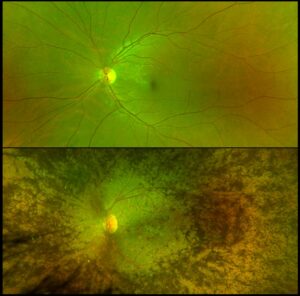By Dr Omar Mahroo, UCL Institute of Ophthalmology, UK
Photoreceptors are the first neurons activated to allow us to see and they are highly specialised cells.
Inherited retinal diseases (most of which are due to problems with photoreceptors) are, as a group, now amongst the largest causes of blindness in children and working age adults in many countries.
Variants in over 250 genes are implicated in inherited retinal diseases, the majority of which lead to disturbances in photoreceptor physiology.
Advances in genomic sequencing allow us to identify the relevant genetic variants in unprecedented numbers of patients, and parallel advances are taking place in understanding how these genetic changes lead to impairment in retinal function.
While most of these conditions are currently untreatable, advances are also being made in developing novel therapies: the first gene replacement therapy has been licensed for treatment of blindness due to changes in both copies of the RPE65 gene.

This gene encodes a protein which is involved in the recycling of the light-sensitive pigment that allows photoreceptors to detect light. Many other novel therapies are undergoing experimental trials.
To explore the latest research in this topic further, at The Physiological Society annual conference in July, we will be hosting a symposium called “Photoreceptors in health and monogenic disease: advances in understanding physiology and treating pathophysiology”.
The symposium is especially timely given recent milestones in understanding photoreceptor physiology and pathophysiology, techniques of in vivo investigation, accessibility of whole genome sequencing and its interpretation, and novel therapies.
The topics are of relevance to physiologists, both scientists and clinicians, particularly those working within visual neuroscience or genetics.
Professor Trevor Lamb, from the Australian National University, will give an overview of the cellular and molecular basis of the light response in rods and cones. These two types of photoreceptors use different isoforms of the relevant molecules, with this duality having evolved over 500 million years ago.
He will cover recent advances, including in our understanding of how rods can reliably respond to single photons. Trevor has made seminal contributions to investigation of phototransduction, and dark adaptation, including pioneering methods of single-cell suction pipette recording and modelling kinetics of the light response and retinoid recycling; many of his discoveries were published in Nature and The Journal of Physiology.
Early career researcher, Xiaofan Jiang (PhD student at University College London, having completed an MSc with distinction at King’s College London) will then discuss how photoreceptor physiology and pathophysiology can be probed in humans in vivo using electrophysiology, including to track dark adaptation in healthy individuals and in patients.
Dr Samantha De Silva is the third speaker. She completed her PhD at the University of Oxford in 2015, investigating optogenetic approaches to restoring vision following photoreceptor degeneration. She has received numerous awards for her work and is now based at the Oxford Eye Hospital. She will present progress in optogenetics, whereby vision can be restored by conferring light sensitivity to remaining second and third order retinal neurons.
Finally, Dr Tony Moore (University of California San Francisco, USA) will discuss how advances in molecular diagnosis and phenotyping have led to improved understanding of monogenic photoreceptor diseases in humans and have thereby informed the development of novel therapies aimed at preventing sight loss or restoring vision in these patients. Tony is a renowned expert in inherited retinal disease, having discovered many of the genes involved, and collaborating in some of the key therapeutic trials in these disorders.
The organisers and co-chairs of this symposium are Dr Omar Mahroo and Dr Emma Duignan. Omar is a Wellcome-funded clinician scientist based at University College London and Moorfields Eye Hospital. He investigates human retinal function in health and disease using in vivo electrophysiology and ancillary techniques including imaging and genetic investigation.
Emma is a retinal specialist currently based at the Royal Victoria Eye and Ear Hospital in Dublin. Her research, based at Trinity College Dublin, investigated genotypes and phenotypes of Irish patients with inherited retinal degeneration.
Given the breadth of topics, the symposium can, with some basis, claim to touch on half a billion years of developments in photoreceptors! Register for Physiology 2021 to hear more.
